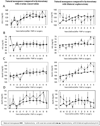Changes in cardiovascular risk factors by hysterectomy status with and without oophorectomy: Study of Women's Health Across the Nation
- PMID: 23684687
- PMCID: PMC3777736
- DOI: 10.1016/j.jacc.2013.04.042
Changes in cardiovascular risk factors by hysterectomy status with and without oophorectomy: Study of Women's Health Across the Nation
Abstract
Objectives: The aim of this study was to compare the changes in risk factors for cardiovascular disease (CVD) leading up to and after hysterectomy with or without bilateral oophorectomy with the changes observed up to and after natural menopause.
Background: Evidence suggests that hysterectomy status with or without bilateral oophorectomy might increase risk for CVD, but most studies retrospectively assess menopausal status.
Methods: Study of Women's Health across the Nation enrolled 3,302 pre-menopausal women not using hormone therapy between 42 and 52 years of age and followed them annually for over 11 years for sociodemographic characteristics, menopausal status, surgeries, body mass index, medication use, lifestyle factors, lipids, blood pressure, insulin resistance, and hemostatic and inflammatory factors. By 2008, 1,769 women had reached natural menopause, 77 women had a hysterectomy with ovarian conservation, and 106 women had a hysterectomy with bilateral oophorectomy. Piece-wise hierarchical growth models compared these groups on annual changes in CVD risk factors before and after final menstrual period or surgery.
Results: Multivariable analyses showed that annual changes in CVD risk factors did not vary by group, with few exceptions, and the significant group differences that did emerge were not in the anticipated direction.
Conclusions: Hysterectomy with or without ovarian conservation is not a key determinant of CVD risk factor status either before or after elective surgery in midlife. These results should provide reassurance to women and their clinicians that hysterectomy in midlife is unlikely to accelerate the CVD risk of women.
Copyright © 2013 American College of Cardiology Foundation. Published by Elsevier Inc. All rights reserved.
Figures

Similar articles
-
Body mass index following natural menopause and hysterectomy with and without bilateral oophorectomy.Int J Obes (Lond). 2013 Jun;37(6):809-13. doi: 10.1038/ijo.2012.164. Epub 2012 Sep 25. Int J Obes (Lond). 2013. PMID: 23007036 Free PMC article.
-
Mood symptoms after natural menopause and hysterectomy with and without bilateral oophorectomy among women in midlife.Obstet Gynecol. 2012 May;119(5):935-41. doi: 10.1097/AOG.0b013e31824f9c14. Obstet Gynecol. 2012. PMID: 22525904 Free PMC article.
-
Is Surgical Menopause Associated With Future Levels of Cardiovascular Risk Factor Independent of Antecedent Levels? The CARDIA Study.Am J Epidemiol. 2015 Dec 15;182(12):991-9. doi: 10.1093/aje/kwv162. Epub 2015 Dec 1. Am J Epidemiol. 2015. PMID: 26628512 Free PMC article.
-
Surgical menopause and cardiovascular risks.Menopause. 2007 May-Jun;14(3 Pt 2):562-6. doi: 10.1097/gme.0b013e318038d333. Menopause. 2007. PMID: 17476145 Review.
-
Menopause Transition and Cardiovascular Disease Risk: Implications for Timing of Early Prevention: A Scientific Statement From the American Heart Association.Circulation. 2020 Dec 22;142(25):e506-e532. doi: 10.1161/CIR.0000000000000912. Epub 2020 Nov 30. Circulation. 2020. PMID: 33251828 Review.
Cited by
-
The interplay between diabetes mellitus and menopause: clinical implications.Nat Rev Endocrinol. 2022 Oct;18(10):608-622. doi: 10.1038/s41574-022-00708-0. Epub 2022 Jul 7. Nat Rev Endocrinol. 2022. PMID: 35798847 Review.
-
Changes in the glucose and insulin responses according to high-protein snacks for diabetic patients.Nutr Res Pract. 2021 Feb;15(1):54-65. doi: 10.4162/nrp.2021.15.1.54. Epub 2020 Oct 12. Nutr Res Pract. 2021. PMID: 33542792 Free PMC article.
-
Cardiometabolic Risk Factors and Benign Gynecologic Disorders.Obstet Gynecol Surv. 2019 Nov;74(11):661-673. doi: 10.1097/OGX.0000000000000718. Obstet Gynecol Surv. 2019. PMID: 31755543 Free PMC article. Review.
-
Hysterectomy With and Without Oophorectomy, Tubal Ligation, and Risk of Cardiovascular Disease in the Nurses' Health Study II.J Womens Health (Larchmt). 2023 Jul;32(7):747-756. doi: 10.1089/jwh.2022.0207. Epub 2023 May 8. J Womens Health (Larchmt). 2023. PMID: 37155739 Free PMC article.
-
Hysterectomy is associated with higher risk of coronary artery disease: A nationwide retrospective cohort study in Taiwan.Medicine (Baltimore). 2018 Apr;97(16):e0421. doi: 10.1097/MD.0000000000010421. Medicine (Baltimore). 2018. PMID: 29668602 Free PMC article.
References
-
- Keshavarz H, Hillis SD, Kieke BA, Marchbanks PA. Hysterectomy surveillance. United States 1994–1999. MMWR CDC Surveill Summ. 2002;51:1–8. - PubMed
-
- Whiteman MK, Hillis SD, Jamieson DJ, et al. Inpatient hysterectomy surveillance in the United States, 2000–2004. Am J Obstet Gynecol. 2008;198:34–37. - PubMed
-
- El-Hemaidi I, Gharaibeh A, Shehata H. Menorrhagia and bleeding disorders. Curr Opin Obstet Gynecol. 2007;19:513–520. - PubMed
-
- Colditz GA, Willett WC, Stampfer MJ, Rosner B, Speizer FE, Hennekens CH. Menopause and the risk of coronary heart disease in women. N Engl J Med. 1987;316:1105–1110. - PubMed
Publication types
MeSH terms
Grants and funding
- TL1 TR000145/TR/NCATS NIH HHS/United States
- UL1 TR000005/TR/NCATS NIH HHS/United States
- U01AG012535/AG/NIA NIH HHS/United States
- U01 AG012554/AG/NIA NIH HHS/United States
- U01AG012546/AG/NIA NIH HHS/United States
- U01AG012531/AG/NIA NIH HHS/United States
- U01AG012505/AG/NIA NIH HHS/United States
- U01AG012539/AG/NIA NIH HHS/United States
- U01 AG012495/AG/NIA NIH HHS/United States
- U01 AG012505/AG/NIA NIH HHS/United States
- U01 AG012531/AG/NIA NIH HHS/United States
- U01NR004061/NR/NINR NIH HHS/United States
- U01AG012553/AG/NIA NIH HHS/United States
- T32 HL007560/HL/NHLBI NIH HHS/United States
- U01AG012495/AG/NIA NIH HHS/United States
- U01 AG012535/AG/NIA NIH HHS/United States
- U01 AG012553/AG/NIA NIH HHS/United States
- U01 NR004061/NR/NINR NIH HHS/United States
- U01 AG012539/AG/NIA NIH HHS/United States
- U01AG012554/AG/NIA NIH HHS/United States
- U01 AG012546/AG/NIA NIH HHS/United States
LinkOut - more resources
Full Text Sources
Other Literature Sources
Medical

